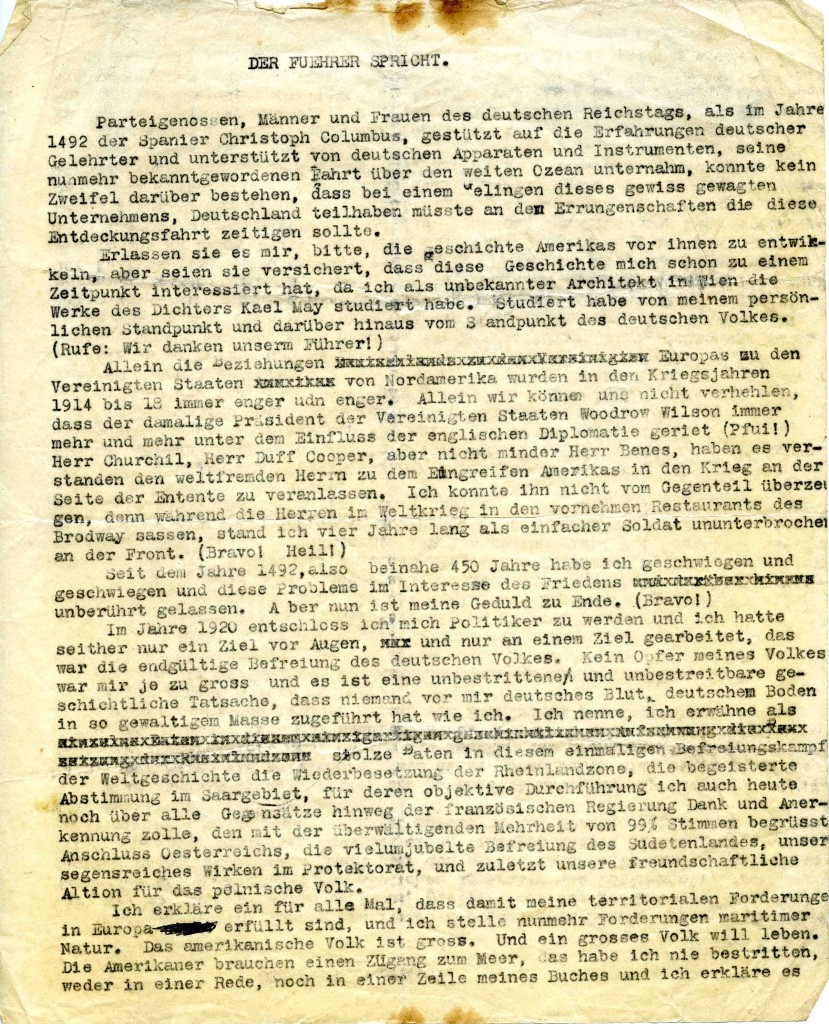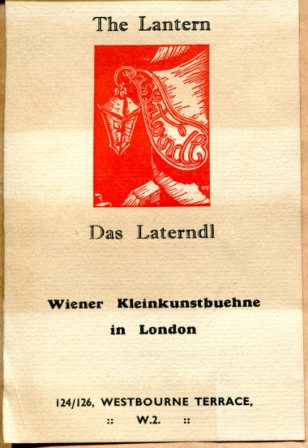Post by Dr Clare George. The second post, about exile libraries, can be found here. The third post, about refugee protection mechanisms, can be found here. Clare is the archivist working on The Martin Miller and Hannah Norbert Miller Archive: An Austrian Jewish Exile Theatre Collection.
Final preparations are underway at the IGRS for the opening of the Miller Archive exhibition on 19th June. The exhibition is part of a larger project to catalogue and promote the use of this collection, a highlight of which is the material on the Austrian exile theatre in London in the Second World War, the Laterndl.
The Laterndl – Austrian Exile Theatre in London

Script of Miller’s Hitler parody, broadcast 1 April 1940
The theatre was the setting for Martin Miller’s first performance of his famous Hitler parody speech, which he was subsequently commissioned to broadcast on BBC radio to Germany on April Fool’s Day 1940. News of the parody reached France, where it was hailed by anti-fascists, and the US, where it gave rise to an alarmed phone call to the BBC from CBS, who had fallen for the spoof.
In an earlier blog post I wrote about the establishment and early days of the Laterndl, whose writers and directors had all worked in Viennese theatres in the 1930s. As exiles in London, they wanted to provide a home for Austrian drama and literature, and to contribute to the fight for an independent and free Austria. The establishment of a German-speaking theatre was also seen as a way of relieving the uprooted exiles’ homesickness, giving them hope and a belief in the future.
The Laterndl‘s first performance took place on 21 June 1939 with Martin Miller as artistic director. At that time, the company was based in Westbourne Terrace near Paddington. The photograph shows Miller with the actress Grete Hartwig watching a rehearsal of their first production, Unterwegs (On the Road). The photo gives some idea of the limited space the company had in which to practise and perform: the auditorium held 60 to 70 seats, and the stage measured just five by three metres.
Unterwegs was typical of many of the Laterndl’s productions in the early years of its existence, when the group was strongly influenced by the Viennese style of cabaret known as Kleinkunstbühne. This was a politically-charged, often satirical, form of revue theatre which had grown out of the politically and culturally repressive conditions of the Austrian capital in the mid- to late-1930s. Unterwegs was composed of nine short sketches interspersed with dances and songs.
The company gained support from influential cultural figures from both Austria and Britain. Amongst the visitors on its opening night were the Austrian writer and novelist Stefan Zweig, the Austrian parodist Robert Neumann, and the English authors H.G. Wells and J.B. Priestley. Although the prime target was the German-speaking exile community, the British press also showed an interest in the opening of the theatre. The Laterndl’s first production was considered a great success and the company went on to perform it to full houses almost 60 times between June and August 1939.
From 1939 until 1946, the Laterndl staged over thirty different productions, in the early years performing on an almost night basis. In doing so the theatre provided the Austrian exile community with a venue for entertainment and refuge from the challenges of everyday life in wartime London. It also gave the exiles the space to reflect on their visions for a different Austria to the one then ruled by the National Socialists from Berlin.
The Millers’ involvement in the Laterndl and other exile theatres in London will be a highlight of the exhibition Theatrical Lives from from Vienna to London, which will be accompanied by a detailed catalogue.
Exhibition details:
Further details and a fascinating insight into project archivist – Clare George’s work on the archive can be found here http://norbertmiller.wordpress.com/category/about-the-project/.
The first blog post about the project (by Dr Christopher Barenberg) can be found here.
The exhibition runs at Senate House from Wednesday, 19 June 2013 to coincide with Refugee Week (17-23 June), until Friday, 30 August 2013. Admission is free. Opening hours: Monday to Saturday, 9:00 to 18:00.





Is there a meeting open to the publlc at 14.00 hours on 3 July (tomorrow)?
If so, where is it?
Hi Nick! Yes, there will be an exhibition launch from 14:00 to 17:00 at Room 102, Senate House. If you’re interested in attending, you should get in touch with the IGRS administrator Jane Lewin as soon as possible to register your attendance (020 7862 8966/Jane.Lewin@sas.ac.uk)